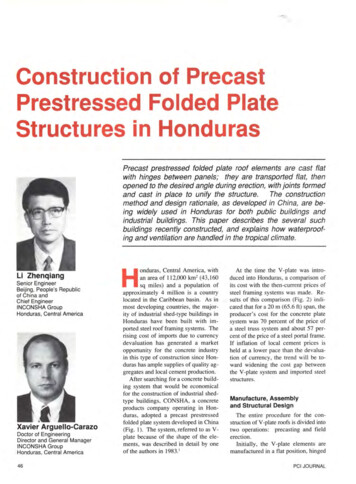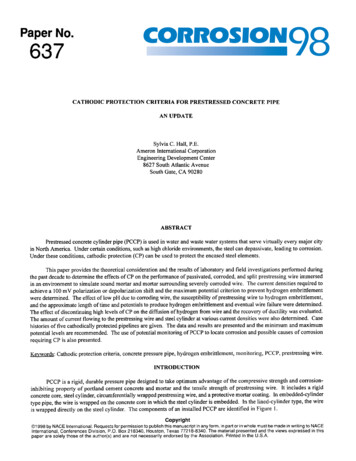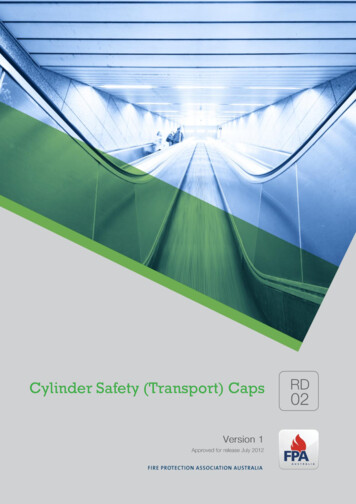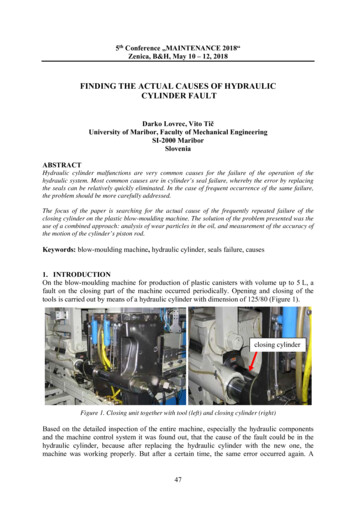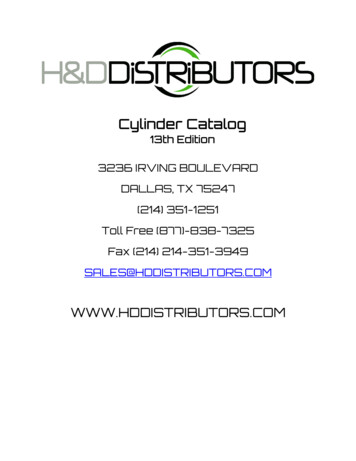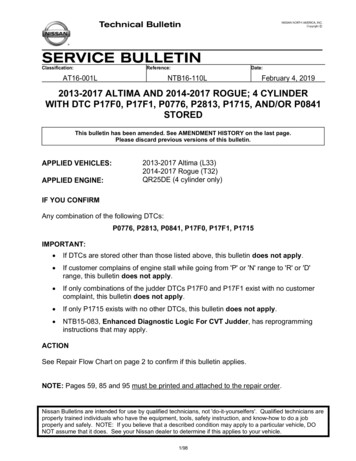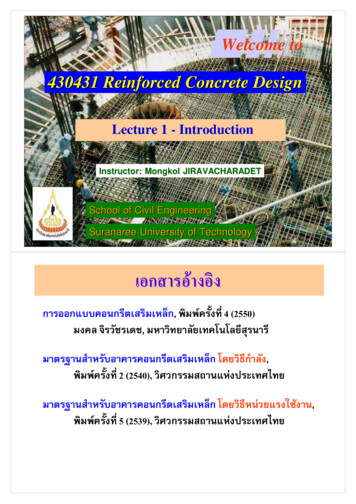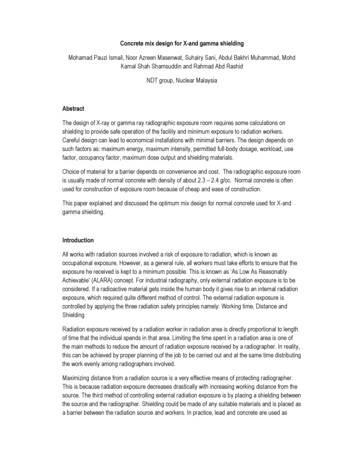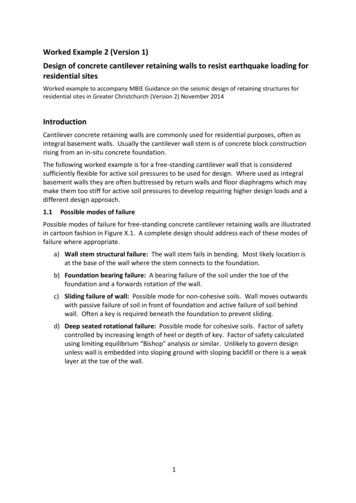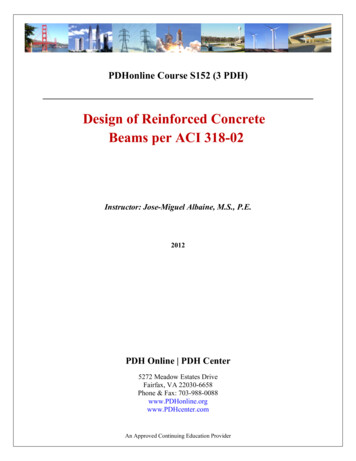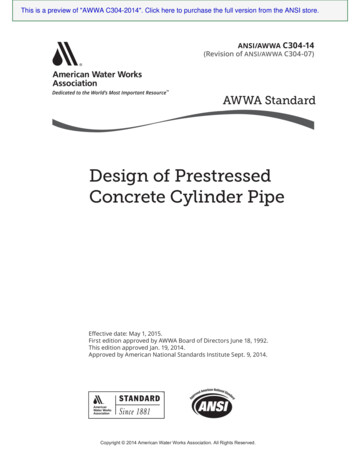
Transcription
This is a preview of "AWWA C304-2014". Click here to purchase the full version from the ANSI store.ANSI/AWWA C304-14(Revision of ANSI/AWWA C304-07)AWWA StandardDesign of PrestressedConcrete Cylinder Pipe( HFWLYH GDWH 0D\ )LUVW HGLWLRQ DSSURYHG E\ :: %RDUG RI 'LUHFWRUV -XQH 7KLV HGLWLRQ DSSURYHG -DQ SSURYHG E\ PHULFDQ 1DWLRQDO 6WDQGDUGV ΖQVWLWXWH 6HSW SM&RS\ULJKW PHULFDQ :DWHU :RUNV VVRFLDWLRQ OO 5LJKWV 5HVHUYHG
This is a preview of "AWWA C304-2014". Click here to purchase the full version from the ANSI store.AWWA Standard7KLV GRFXPHQW LV DQ PHULFDQ :DWHU :RUNV VVRFLDWLRQ :: VWDQGDUG ΖW LV QRW D VSHFLȴFDWLRQ :: VWDQGDUGV GHVFULEH PLQLPXP UHTXLUHPHQWV DQG GR QRW FRQWDLQ DOO RI WKH HQJLQHHULQJ DQG DGPLQLVWUDWLYH LQIRUPDWLRQ QRUPDOO\ FRQWDLQHG LQ VSHFLȴFDWLRQV 7KH :: VWDQGDUGV XVXDOO\ FRQWDLQ RSWLRQV WKDW PXVW EH HYDOXDWHG E\ WKH XVHU RI WKH VWDQGDUG 8QWLO HDFK RSWLRQDO IHDWXUH LV VSHFLȴHG E\ WKH XVHU WKH SURGXFW RU VHUYLFH LV QRW IXOO\ GHȴQHG :: SXEOLFDWLRQ RI D VWDQGDUG GRHV QRW FRQVWLWXWH HQGRUVHPHQW RI DQ\ SURGXFW RU SURGXFW W\SH QRU GRHV :: WHVW FHUWLI\ RU DSSURYH DQ\ SURGXFW 7KH XVH RI :: VWDQGDUGV LV HQWLUHO\ YROXQWDU\ 7KLV VWDQGDUG GRHV QRW VXSHUVHGH RU WDNH SUHFHGHQFH RYHU RU GLVSODFH DQ\ DSSOLFDEOH ODZ UHJXODWLRQ RU FRGH RI DQ\ JRYHUQPHQWDO DXWKRULW\ :: VWDQGDUGV DUH LQWHQGHG WR UHSUHVHQW D FRQVHQVXV RI WKH ZDWHU VXSSO\ LQGXVWU\ WKDW WKH SURGXFW GHVFULEHG ZLOO SURYLGH VDWLVIDFWRU\ VHUYLFH :KHQ :: UHYLVHV RU ZLWKGUDZV WKLV VWDQGDUG DQ RɝFLDO QRWLFH RI DFWLRQ ZLOO EH SODFHG LQ WKH 2ɝFLDO 1RWLFH VHFWLRQ RI -RXUQDO PHULFDQ :DWHU :RUNV VVRFLDWLRQ 7KH DFWLRQ EHFRPHV H HFWLYH RQ WKH ȴUVW GD\ RI WKH PRQWK IROORZLQJ WKH PRQWK RI -RXUQDO PHULFDQ :DWHU :RUNV VVRFLDWLRQ SXEOLFDWLRQ RI WKH RɝFLDO QRWLFH American National Standard Q PHULFDQ 1DWLRQDO 6WDQGDUG LPSOLHV D FRQVHQVXV RI WKRVH VXEVWDQWLDOO\ FRQFHUQHG ZLWK LWV VFRSH DQG SURYLVLRQV Q PHULFDQ 1DWLRQDO 6WDQGDUG LV LQWHQGHG DV D JXLGH WR DLG WKH PDQXIDFWXUHU WKH FRQVXPHU DQG WKH JHQHUDO SXEOLF 7KH H[LVWHQFH RI DQ PHULFDQ 1DWLRQDO 6WDQGDUG GRHV QRW LQ DQ\ UHVSHFW SUHFOXGH DQ\RQH ZKHWKHU WKDW SHUVRQ KDV DSSURYHG WKH VWDQGDUG RU QRW IURP PDQXIDFWXULQJ PDUNHWLQJ SXUFKDVLQJ RU XVLQJ SURGXFWV SURFHVVHV RU SURFHGXUHV QRW FRQIRUPLQJ WR WKH VWDQGDUG PHULFDQ 1DWLRQDO 6WDQGDUGV DUH VXEMHFW WR SHULRGLF UHYLHZ DQG XVHUV DUH FDXWLRQHG WR REWDLQ WKH ODWHVW HGLWLRQV 3URGXFHUV RI JRRGV PDGH LQ FRQIRUPLW\ ZLWK DQ PHULFDQ 1DWLRQDO 6WDQGDUG DUH HQFRXUDJHG WR VWDWH RQ WKHLU RZQ UHVSRQVLELOLW\ LQ DGYHUWLVLQJ DQG SURPRWLRQDO PDWHULDOV RU RQ WDJV RU ODEHOV WKDW WKH JRRGV DUH SURGXFHG LQ FRQIRUPLW\ ZLWK SDUWLFXODU PHULFDQ 1DWLRQDO 6WDQGDUGV C AUTION NOTICE: 7KH PHULFDQ 1DWLRQDO 6WDQGDUGV ΖQVWLWXWH 16Ζ DSSURYDO GDWH RQ WKH IURQW FRYHU RI WKLV VWDQGDUG LQGLFDWHV FRPSOHWLRQ RI WKH 16Ζ DSSURYDO SURFHVV 7KLV PHULFDQ 1DWLRQDO 6WDQGDUG PD\ EH UHYLVHG RU ZLWKGUDZQ DW DQ\ WLPH 16Ζ SURFHGXUHV UHTXLUH WKDW DFWLRQ EH WDNHQ WR UHDɝUP UHYLVH RU ZLWKGUDZ WKLV VWDQGDUG QR ODWHU WKDQ ȴYH \HDUV IURP WKH GDWH RI 16Ζ DSSURYDO 3XUFKDVHUV RI PHULFDQ 1DWLRQDO 6WDQGDUGV PD\ UHFHLYH FXUUHQW LQIRUPDWLRQ RQ DOO VWDQGDUGV E\ FDOOLQJ RU ZULWLQJ WKH PHULFDQ 1DWLRQDO 6WDQGDUGV ΖQVWLWXWH :HVW UG 6WUHHW )RXUWK )ORRU 1HZ RUN 1 RU HPDLOLQJ LQIR#DQVL RUJ This AWWA content is the product of thousands ofhours of work by your fellow water professionals.Revenue from the sales of this AWWA material supportsongoing product development. Unauthorized distribution,either electronic or photocopied, is illegal and hindersAWWA’s mission to support the water community.Ζ6%1 SULQW HΖ6%1 HOHFWURQLF '2Ζ KWWS G[ GRL RUJ :: & OO ULJKWV UHVHUYHG 1R SDUW RI WKLV SXEOLFDWLRQ PD\ EH UHSURGXFHG RU WUDQVPLWWHG LQ DQ\ IRUP RU E\ DQ\ PHDQV HOHFWURQLF RU PHFKDQLFDO LQFOXGLQJ SKRWRFRS\ UHFRUGLQJ RU DQ\ LQIRUPDWLRQ RU UHWULHYDO V\VWHP H[FHSW LQ WKH IRUP RI EULHI H[FHUSWV RU TXRWDWLRQV IRU UHYLHZ SXUSRVHV ZLWKRXW WKH ZULWWHQ SHUPLVVLRQ RI WKH SXEOLVKHU &RS\ULJKW k E\ PHULFDQ :DWHU :RUNV VVRFLDWLRQ3ULQWHG LQ 86 LL&RS\ULJKW PHULFDQ :DWHU :RUNV VVRFLDWLRQ OO 5LJKWV 5HVHUYHG
This is a preview of "AWWA C304-2014". Click here to purchase the full version from the ANSI store.Committee PersonnelThe AWWA Standards Subcommittee on ANSI/AWWA C304, which reviewed and developedthis standard, had the following personnel at the time:Armand W. Tremblay, ChairJ.G. Grunow, Louisville Water Company, Louisville, Ky.J.J. Roller, CTLGroup, Skokie, Ill.A.W. Tremblay, Tipp City, OhioJ.A. Tully, Munro Ltd., Utopia, Ont., CanadaM.S. Zarghamee, Simpson Gumpertz & Heger Inc., Waltham, Mass.(AWWA)(AWWA)(AWWA)(AWWA)(AWWA)The AWWA Standards Committee on Concrete Pressure Pipe, which reviewed and approved thisstandard, had the following personnel at the time of approval:Wayne R. Brunzell, ChairRichard I. Mueller, SecretaryUser MembersK.A. Danley, Des Moines Water Works, Des Moines, IowaW.C. Duke, Bureau of Reclamation, Denver, Colo.N.D. Faber, San Diego County Water Authority, Escondido, Calif.J.A. Fleming,* Standards Council Liaison, Greater Cincinnati Water Works,(AWWA)(USBR)(AWWA)Cincinnati, OhioJ.G. Grunow, Louisville Water Company, Louisville, Ky.D.H. Marshall, Tarrant Regional Water District, Fort Worth, TexasN.A. Wigner, Los Angeles Department of Water and Power, Los Angeles, Calif.(AWWA)(AWWA)(AWWA)(AWWA)General Interest MembersH.H. Bardakjian, Consulting Engineer, Glendale, Calif.G.E.C. Bell, HDR Schiff, Claremont, Calif.W.R. Brunzell, Brunzell Associates Ltd., Skokie, Ill.B.C. Coltharp, Freese & Nichols Inc., Dallas, TexasD. Dechant, Dechant Infrastructure Services, Aurora, Colo.* Liaison, nonvotingLLL&RS\ULJKW PHULFDQ :DWHU :RUNV VVRFLDWLRQ OO 5LJKWV 5HVHUYHG (AWWA)(AWWA)(AWWA)(AWWA)(AWWA)
This is a preview of "AWWA C304-2014". Click here to purchase the full version from the ANSI store.F.S. Kurtz,* Standards Engineer Liaison, AWWA, Denver, Colo.S.A. McKelvie,† HDR Engineering Inc., Boston, Mass.T.L. Niemann, Louisville, Ky.J.J. Roller, CTLGroup, Skokie, Ill.A.E. Romer, AECOM, Orange, Calif.C.C. Sundberg,† CH2M HILL, Issaquah, Wash.T.A. Tovey, CH2M HILL, Bellevue, Wash.A.W. Tremblay, Tipp City, OhioM.S. Zarghamee, Simpson Gumpertz & Heger Inc., Waltham, WA)(AWWA)Producer MembersS.A. Arnaout, Hanson Pressure Pipe, Grand Prairie, TexasG. Bizien,† Hanson Pressure Pipe, St. Eustache, Que., CanadaK.M. Brown, Vianini Pipe Inc., Somerville, N.J.G.A. Davidenko, Northwest Pipe Company, Saginaw, TexasB.D. Keil,† Northwest Pipe Company, Draper, UtahR.I. Mueller, American Concrete Pressure Pipe Association, Orange, Calif.J. Olmos, NOV Ameron, Rancho Cucamonga, Calif.J.A. Tully, Munro Ltd., Utopia, Ont., Canada* Liaison, nonvoting† AlternateLY&RS\ULJKW PHULFDQ :DWHU :RUNV VVRFLDWLRQ OO 5LJKWV 5HVHUYHG (AWWA)(AWWA)(AWWA)(AWWA)(AWWA)(ACPPA)(AWWA)(AWWA)
This is a preview of "AWWA C304-2014". Click here to purchase the full version from the ANSI store.ContentsAll AWWA standards follow the general format indicated subsequently. Some variations from thisformat may be found in a particular standard.6(& 3 *(6(& 3 *(ForewordIIntroduction . ix3Load and Internal-PressureCombinationsI.ABackground . ix3.1Notation. 8I.BHistory. . xiii3.2I.CAcceptance . xiiiLoad Factors for Limit-StatesDesign. 8IISpecial Issues . xiv3.3IIIUse of This Standard . xivMinimum Combined Design Loadsand Pressures . 9III.A Purchaser Options andAlternatives . xiv3.4Working Loads and InternalPressures. 9III.B Modification to Standard . xv3.5Working Plus Transient Loads andInternal Pressures . 93.6Working Loads and InternalField-Test Pressures . 10Standard3.7Load and Pressure Factors . 101General4Moments and Thrusts1.1Scope . 14.1Notation. 111.2References . 14.2Distribution of Loads . 121.3Applications . 24.3Moments and Thrusts . 131.4Pipe Structure . 35Design Material Properties1.5Tolerances . 45.1Notation. 141.6Definitions . 45.21.7Metric (SI) Equivalents. 4Materials and ManufacturingStandard. 152Loads and Internal Pressures5.3Properties of Core Concrete . 152.1Notation. 55.4Properties of Coating Mortar . 202.2Design Loads and InternalPressures. 65.5Properties of Steel Cylinder . 205.6Properties of Prestressing Wire . 222.3Loads . 66Stresses From Prestressing2.4Internal Pressures . 76.1Notation. 23IVMajor Revisions. xvVComments . xviY&RS\ULJKW PHULFDQ :DWHU :RUNV VVRFLDWLRQ OO 5LJKWV 5HVHUYHG
This is a preview of "AWWA C304-2014". Click here to purchase the full version from the ANSI store.6(& 3 *(6(& 3 *(6.2Prestress Losses. 246.3State of Stress With a Single Layerof Prestressing . 246.4State of Stress With Multiple Layersof Prestressing . 256.5Modular Ratios . 266.6Design Creep Factor and DesignShrinkage Strain forBuried Pipe . 266.7Wire-Relaxation Factor . 29Appendixes7Criteria for Limit-State Loadsand PressuresACommentary . 817.1Notation. 30BReferences . 937.2Limit-States Design . 31CPipe-Design Example . 957.3Serviceability Limit-States DesignCriteria . 317.4Elastic Limit-States DesignCriteria . 327.5Strength Limit-States DesignCriteria . 338Calculation of Limit-State Loadsand Pressures8.1Notation. 348.2Limit-States Design Procedures . 378.3Maximum Pressures . 378.4Maximum Thrust. 408.5Burst Pressure. 408.6Radial Tension . 408.7Combined Loads and InternalPressures at Design LimitStates . 418.8Lines of Action of Thrusts . 418.9Conformance With Limit-StatesCriteria . 429Design Selection Tables9.1Design Example 1 . 569.2Design Example 2 . 569.3Design Example 3 . 579.4Lined-Cylinder Pipe StandardPrestress Design Tables . 57Figures1 Schematic Pipe-Wall Cross Sectionsfor LCP and ECP . 32Stress–Strain Relationships for ConcreteAnd Mortar in Tension andCompression . 183Stress–Strain Relationship for SteelCylinder in Tension andCompression . 214Stress–Strain Relationship for 6-GaugePrestressing Wire in TensionAfter Wrapping at fsg . 225Schematic of Strain and StressDistributions in Pipe-Wall CrossSection at Invert and Crown. 446Schematic of Strain and StressDistributions in Pipe-Wall CrossSection at Springline . 48YL&RS\ULJKW PHULFDQ :DWHU :RUNV VVRFLDWLRQ OO 5LJKWV 5HVHUYHG
This is a preview of "AWWA C304-2014". Click here to purchase the full version from the ANSI store.6(& 3 *(6(& 7 Schematic of Strain and StressDistributions for Computation ofM2-Moment Limit for UltimateCompressive Strength of CoreConcrete. 518Schematic of Strain and StressDistributions for Computationof M1-Moment Limit forUltimate Compressive Strengthof Coating . 539 Bedding Details for Prestressed ConcreteCylinder Pipe EmbankmentCondition. 79A.1 Mean Annual Number of DaysMaximum Temperature of 90 F(32 C) and Above, Except 70 F(21 C) and Above in Alaska. 87A.2Mean Relative Humidity(January–March) . 88A.3Mean Relative Humidity(April–June) . 89A.4Mean Relative Humidity(July–September) . 90A.5Mean Relative Humidity(October–December) . 91Tables1Load and Pressure Factors forEmbedded-Cylinder Pipe . 102Load and Pressure Factors forLined-Cylinder Pipe . 113Design Load Combinations andCalculation References forEmbedded-Cylinder PipeCriteria . 383 *(4Design Load Combinations andCalculation References forLined-Cylinder Pipe Criteria . 395Standard Prestress Design—16 In.(410 mm) Lined-CylinderPipe . 596Standard Prestress Design—18 In.(460 mm) Lined-CylinderPipe . 617Standard Prestress Design—20 In.(510 mm) Lined-CylinderPipe . 638Standard Prestress Design—24 In.(610 mm) Lined-CylinderPipe . 659Standard Prestress Design—30 In.(760 mm) Lined-CylinderPipe . 6710Standard Prestress Design—36 In.(910 mm) Lined-CylinderPipe . 6911Standard Prestress Design—42 In.(1,070 mm) Lined-CylinderPipe . 7112Standard Prestress Design—48 In.(1,220 mm) Lined-CylinderPipe . 7313Standard Prestress Design—54 In.(1,370 mm) Lined-CylinderPipe . 7514Standard Prestress Design—60 In.(1,520 mm) Lined-CylinderPipe . 77YLL&RS\ULJKW PHULFDQ :DWHU :RUNV VVRFLDWLRQ OO 5LJKWV 5HVHUYHG
This is a preview of "AWWA C304-2014". Click here to purchase the full version from the ANSI store.This page intentionally blank.&RS\ULJKW PHULFDQ :DWHU :RUNV VVRFLDWLRQ OO 5LJKWV 5HVHUYHG
This is a preview of "AWWA C304-2014". Click here to purchase the full version from the ANSI store.ForewordThis foreword is for information only and is not a part of ANSI*/AWWA C304.I.Introduction.I.A. Background. This standard establishes the mandatory minimumrequirements for the structural design of prestressed concrete cylinder pipe (PCCP)and provides procedures that will ensure that the design requirements are satisfied.There are two types of PCCP: (1) lined-cylinder pipe (LCP), with a core composedof a steel cylinder lined with concrete, which is subsequently prestressed with hightensile wire wrapped directly around the steel cylinder; and (2) embedded-cylinderpipe (ECP), with a core composed of a steel cylinder encased in concrete, which issubsequently prestressed with high-tensile wire wrapped around the exterior concretesurface. The cores of both types of pipe are coated with portland-cement mortar.Before the procedures and requirements contained in this document were developed, the design of PCCP was determined by two distinct procedures. These were designated methods A and B described in appendixes A and B of ANSI/AWWA C301-84,Prestressed Concrete Pressure Pipe, Steel-Cylinder Type, for Water and Other Liquids.Method A used a semiempirical approach based on (1) Wo , which is nine-tenths ofthe three-edge bearing test load that causes incipient cracking; and (2) the theoreticalhydrostatic pressure, Po , which relieves the calculated residual compression in the concrete core as a result of prestressing. The allowable combinations of three-edge bearingload and internal pressure were determined by a cubic parabola, passing through Woand Po , which defined the limits of these combinations. The three-edge bearing loadsused in method A were converted to earth loads and transient external loads using bedding factors provided in AWWA Manual M9, Concrete Pressure Pipe (1979) and in theACPA† Concrete Pipe Design Manual (1988).Method B was based on a procedure that limited the maximum combined nettensile stress in pipe under static external load and internal pressure to a value equal to7.5 f c , where f c the 28-day compressive strength of core concrete in psi (0.62 f c ,where f c the 28-day compressive strength of core concrete in MPa).Both design methods limited the working pressure to Po for ECP and to 0.8Pofor LCP, where Po was the internal pressure required to overcome all compression in* American National Standards Institute, 25 West 43rd Street, Fourth Floor, New York, NY 10036.† American Concrete Pipe Association, 1303 West Walnut Hill Lane, Suite 305, Irving, TX 75038.L[&RS\ULJKW PHULFDQ :DWHU :RUNV VVRFLDWLRQ OO 5LJKWV 5HVHUYHG
This is a preview of "AWWA C304-2014". Click here to purchase the full version from the ANSI store.the core concrete excluding external load. Under transient conditions, such as thoseproduced by surge pressures and live loads, both methods permitted increased internalpressure and external load.Although the two methods of design produced similarly conservative results thatserved PCCP users well for nearly half a century, a unified method of design, describedin this standard, was developed to replace methods A and B.The following objectives for the unified design procedure were established:1. It should replace both existing methods, the semiempirical method A andthe working stress method B, described in ANSI/AWWA C301-84.2. It should be based on state-of-the-art procedures for the design and analysisof concrete and prestressed concrete structures.3. It should account for the state of prestress in the pipe, as well as the combined effects of external loads, pipe and fluid weights, and internal pressures.4. It should agree with the results of 40 years of experimental data gathered bythe American concrete pressure-pipe industry.5. It should preclude the onset of visible cracking under working plus transientconditions.6. It should provide adequate safety factors based on elastic and strength limitstates.The method of calculating residual stresses in the concrete core, the steel cylinder,and the prestressing wire was updated to separately account for the effects of elasticdeformation, creep, and shrinkage of concrete, and the relaxation of the prestressing wire(Zarghamee, Heger, and Dana 1988a; see appendix B). Intrinsic wire relaxation, creepfactors, and shrinkage strains obtained from procedures recommended by ACI* Committee 209 (1982) (ACI 1982; see appendix B) were used in a step-by-step integrationprocedure (Zarghamee 1990; see appendix B) to evaluate the time-related variations ofstress in the pipe elements. The results of the step-by-step integration procedure, appliedto pipe in a buried environment, were used to develop simplified equations for practicaldesign use.Calculations of the design creep factor and shrinkage strain for buried pipe arebased on the procedures recommended by
The AWWA Standards Committee on Concrete Pressure Pipe, which reviewed and approved this standard, had the following pe
